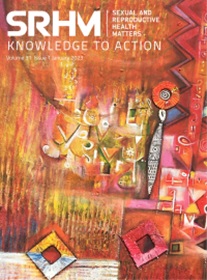控制生育:妇女、社会和国家权力
IF 3.3
2区 医学
Q1 PUBLIC, ENVIRONMENTAL & OCCUPATIONAL HEALTH
引用次数: 0
摘要
我发现这是一本引人入胜的书,作者是一位社会学家和一位人类学家,涵盖了他们的学科,也涉及了相当多的政治。它应该对普通SRHM期刊读者开放。我觉得比起从人口统计学的角度来看,我对这个问题有了更深入的了解。也许,对伦理方面多一点分析会使它更加全面。这本书提供了一个广泛的情况分析-à-vis限制生殖自主在世界各地与许多国家和政权的深入评估。它是最新的,考虑到罗伊诉韦德案的推翻。范围主要是生育控制,但也有关于辅助生殖技术、代孕和收养的章节。这本书集中在宏观层面,没有涵盖微观层面的强制控制。它包括抵抗干扰生殖的各种形式。描述了秘密使用避孕措施,但没有明确定义。强调个人和他们的身体是如何受到不当控制的伤害,以及通过什么机制受到伤害。宗教、州政府和家庭被认为是干扰和限制个人生育愿望/目标的主要来源。当然,父权制是这一切的基础。全球资本主义/新自由主义以牺牲人民为代价而获得的突出地位也是如此;新自由主义无处不在的负面影响贯穿全书。关于非政府组织和企业在据称赋予妇女权力的项目中所扮演的角色,有一些有趣的见解;然而,慈善资本主义并没有被提及。全球北方的价值观经常强加给全球南方的情况是明确的。书中反复提到殖民主义、种族主义和性别不平等所起的作用。然而,没有提到普遍使用的“未满足避孕需求指标”驱动程序的缺陷。我还认为,需要更多的工作来拆解方案的自愿性和界定生殖自主。菲律宾人的特殊困境是一个详细的例子:由于缺乏国家服务和随之而来的贫穷,他们被迫移徙并向家人汇款- -结果失去了对其生育目标的个人控制。美国的财政援助在印度、秘鲁、菲律宾和埃及等国的项目中占主导地位。这句话出自一个不认为贫穷是结构性暴力的国家。不幸的是,真正的选择只提供给那些有真正选择的人。所提供的援助往往与调查数据相匹配,这些数据衡量的是西方对个人的看法,而忽略了结构背景。“结构调整方案”往往强加外部资金的条件:具体的降低生育率目标、减少国家补贴、提高商品和服务的价格- -所有这些都使个人行为倾向于市场,而不是作为社区或家庭的一部分行事。社会上巨大的不平等问题没有得到解决。报告明确指出,将计划生育方案与更广泛的一般保健和社会服务分开是多么有害。作者描述了女孩的教育如何被促进为具有多重有益的影响;不幸的是,方案强调财务和创业技能,鼓励女孩摆脱她们的文化信仰和习俗。波兰教会与国家之间的强大联盟理所当然地得到了突出的重视,书的封面上出现了妇女罢工运动的象征。正如美国作家所期望的那样,基督教右翼对“家庭价值观”的推崇远远超出了美国,这是一个很好的解释。母亲的压力贯穿全书——也许是被评判为“书架”的概念本文章由计算机程序翻译,如有差异,请以英文原文为准。
Controlling reproduction: women, society, and state power
I found this a fascinating book – written by a sociologist and an anthropologist, covering their disciplines and a fair amount of politics too. It should be accessible to the general SRHM journal readership. I felt I got a much richer insight into the subject than I would have done from a more demography-dominant perspective. Perhaps, a little more analysis of ethical aspects would have made it even more comprehensive. The book provides a wide-ranging analysis of the situation vis-à-vis restrictions to reproductive autonomy around the world with in-depth assessments of many countries and regimes. It is up to date, taking into account the overturning of Roe v. Wade. The scope is mainly fertility control but there are sections on assisted reproductive technology, surrogacy and adoption too. The book concentrates on the macro level and does not cover coercive control at the micro level. It includes forms of resistance to interference with reproduction. Covert contraceptive use is described, without explicitly defining it as such. There is an emphasis on how individuals and their bodies are harmed by undue control and by what mechanism. Religion, state governments and families are presented as major sources of interference with and constraint of an individual’s reproductive wishes/goals. Of course, patriarchy underlies all of this. So too does the prominence given to global capitalism/neoliberalism at the expense of the people; the pervasive adverse effect of neoliberalism runs as a thread throughout the book. There are interesting insights into the part NGOs and corporations play in programmes that purportedly empower women; however philanthro-capitalism is not mentioned. The frequent imposition of Global North values on the Global South is clearly stated. There are repeated references to the part played by colonialism, racism and gender inequality. However, the flaws in the universally used driver of the “unmet need for contraception indicator” are not mentioned. I also felt that more was needed to unpick the voluntariness of programmes and in defining reproductive autonomy. The particular plight of Filipinas is given as a detailed example: forced by lack of state services and ensuing poverty to migrate and send remittances back to their family – with the resultant loss of personal control over their reproductive goals. Financial aid from the US has dominated programmes such as those in India, Peru, the Philippines and Egypt. This from a country that does not recognise poverty as structural violence. Unfortunately, real choice is only available to those who have genuine options. Aid supplied is often matched to data from surveys that measure a Western view of individuals, ignoring the structural context. Often, “structural adjustment programmes” impose conditions for external funding: specific fertility reduction goals, reduction of state subsidies, increased prices of goods and services – which all shape individual behaviour toward a market orientation and away from acting as part of a community or family. The vast inequalities in society are left unaddressed. It is made clear how damaging it is to separate out family planning programmes from wider general health and social services. The authors describe how education of girls is promoted as having multiple beneficial effects; unfortunately, financial and entrepreneurial skills are emphasised in programmes and girls are encouraged to break free from their cultural beliefs and practices. The strong alliance between church and state in Poland is, rightly, given prominence, with the symbol of the Women’s Strike movement being featured on the book cover. As would be expected from US authors, there is a good explanation of the Christian Right with its promotion of “family values” extending far beyond the US. The pressure for motherhood is referred to throughout the book – perhaps the concept of being judged as BOOKSHELF
求助全文
通过发布文献求助,成功后即可免费获取论文全文。
去求助
来源期刊

Sexual and Reproductive Health Matters
Medicine-Obstetrics and Gynecology
CiteScore
4.00
自引率
8.30%
发文量
63
审稿时长
16 weeks
期刊介绍:
SRHM is a multidisciplinary journal, welcoming submissions from a wide range of disciplines, including the social sciences and humanities, behavioural science, public health, human rights and law. The journal welcomes a range of methodological approaches, including qualitative and quantitative analyses such as policy analysis; mixed methods approaches to public health and health systems research; economic, political and historical analysis; and epidemiological work with a focus on SRHR. Key topics addressed in SRHM include (but are not limited to) abortion, family planning, contraception, female genital mutilation, HIV and other STIs, human papillomavirus (HPV), maternal health, SRHR in humanitarian settings, gender-based and other forms of interpersonal violence, young people, gender, sexuality, sexual rights and sexual pleasure.
 求助内容:
求助内容: 应助结果提醒方式:
应助结果提醒方式:


